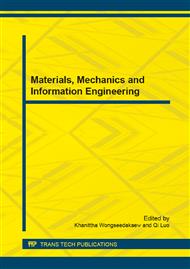[1]
Vinarcik, E. J.: High Integrity Die Casting Processes, John Wiley and Sons, New York, (2003).
Google Scholar
[2]
Gaspar, S., Pasko, J.: Metal flow velocity in an intake port in the process of die casting, Advanced Materials research, Vol. 705, 2013, pp.177-180.
DOI: 10.4028/www.scientific.net/amr.705.177
Google Scholar
[3]
Gaspar, S., J. Pasko: Influence of technological factors of die casting on mechanical properties of castings from silumin, Lecture Notes in Electrical Engineering, Vol. 240, 2013, pp.713-722.
DOI: 10.1007/978-94-007-6738-6_88
Google Scholar
[4]
P. Bigos, M. Puskar, L. Pesek: Assessment of the critical places in the casted piston based on a local strength – microstructure model, Chemical Letters. Vol. 106, no. S3 (2012) 379-382.
Google Scholar
[5]
N. Jasminska, T. Brestovic: Possibilities of using plastics in the design of water heater tankg, Acta Mechanica Slovaca, Vol. 17, no. 3(2013), pp.34-41.
DOI: 10.21496/ams.2013.030
Google Scholar
[6]
N. Jasminska, T. Brestovic, M. Carnogurska: The effect of temperature pyrolysis process of used tires on the quality of output products, Acta Mechanica Slovaca, Vol. 17, no. 1 (2013), pp.20-25.
DOI: 10.2478/ama-2013-0004
Google Scholar
[7]
J. Ruzbarsky – J. Zarnovsky.: Optimization of parameters in the compression moulding process of thermoset products, Advanced Materials Research, Vol. 801, 2013, pp.61-66.
DOI: 10.4028/www.scientific.net/amr.801.61
Google Scholar
[8]
S. Gaspar, J. Mascenik, J. Pasko: The effect of degassing pressure casting molds on quality of pressure casting, Adv. Mater. Res. Vol. 428 (2012) pp.43-46.
DOI: 10.4028/www.scientific.net/amr.428.43
Google Scholar
[9]
J. Mascenik, The evacuation of pressure moulds as progressive developments of die casting process, Bulletin of engineering. Vol. 5 (2012) pp.25-26.
Google Scholar
[10]
J.C. Choi, T.H. Kwon, J.H. Park, J.H. Kim, C.H. Kim, A study on development of a die design for die casting, Int. J. Adv. Manuf. Technol. 20 (2012) 1-8.
Google Scholar
[11]
J. Mascenik, S. Gaspar: Experimental Assessment of Roughness Changes in the Cutting Surface and Microhardness Changes of the Material S 355 J2 G3 after Being Cut by Non-Conventional Technologies, Advanced Materials Research, Vol. 314-316, 2011, p.1944-(1947).
DOI: 10.4028/www.scientific.net/amr.314-316.1944
Google Scholar
[12]
J. Pasko, S. Gaspar: Homogeneity and the height of the metal rest inside a filling chamber of die casting machine, Advanced Materials Research, Vol. 746, 2013, pp.457-461.
DOI: 10.4028/www.scientific.net/amr.746.457
Google Scholar


